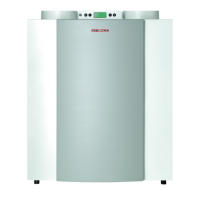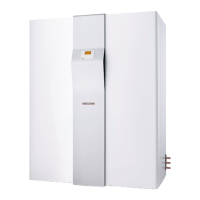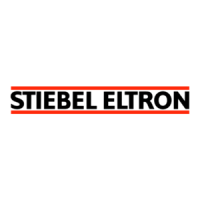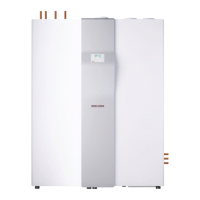
Do you have a question about the STIEBEL ELTRON LWZ 130 and is the answer not in the manual?
| Brand | STIEBEL ELTRON |
|---|---|
| Model | LWZ 130 |
| Category | Fan |
| Language | English |
Guidance on safe appliance usage, including symbols, risk levels, and keywords.
Explains symbols used for general information and material losses within the manual.
Defines the appliance's purpose as a mechanical ventilation unit for domestic use.
Provides warnings about appliance usage by children and potential hazards like condensation.
Refers to symbols on the appliance's type plate for identification and testing.
Explains how frost protection prevents the heat exchanger from freezing.
Describes the function of passive cooling using a bypass for temperature regulation.
Details the enthalpy heat exchanger's role in moisture transfer for better indoor climate.
Explains that the appliance operates when powered, lacking a physical ON/OFF switch.
Introduces the programming unit and its controls for appliance settings and operation.
Details the function of buttons like MENU, OK, HOME, and Intensive Ventilation.
Explains the meaning of various symbols shown on the appliance display.
Describes how to select fan stages 0, 1, 2, and activate intensive ventilation.
Explains how to activate time programs using the Touch-Wheel and the 'time' symbol.
Sets the target room temperature, influencing passive cooling and frost protection.
Defines the operating mode for passive cooling based on various conditions.
Resets the filter runtime counter after filter replacement.
Allows enabling or disabling the appliance fans for specific operational needs.
Controls display backlighting: always on, off, or automatic based on user activity.
Sets the time duration for the display backlighting to remain active after user input.
Defines what information is shown in the lower section of the standard appliance display.
Lists various measured values like temperatures, humidity, and filter service life.
Details how to set up 21 time programs for automated appliance operation.
Enables access to qualified contractor settings using a four-digit code.
Instructs on how to disconnect the appliance from the power supply for maintenance.
Lists part numbers and classifications for replacement filters.
Provides detailed instructions and warnings for inspecting and replacing appliance filters.
Detailed steps for inspecting and replacing coarse particle and outdoor air filters.
Lists detected faults, their effects, and remedies, advising to contact a qualified contractor.
Emphasizes using original accessories and following safety guidelines during installation.
Highlights adherence to national and regional fire prevention and building regulations.
Details safety measures for simultaneous operation with combustion equipment.
Covers planning safety measures for simultaneous operation, including alternate and simultaneous modes.
Explains the importance of checking for harmful combustion exhaust gas penetration during commissioning.
Describes regular maintenance of combustion equipment and safety checks.
Lists items included with the appliance, such as programming unit and anti-vibration mounts.
Lists optional accessories like air duct connectors and condensate pumps.
Provides instructions for storing the appliance to prevent damage.
Specifies requirements for the installation site, including safety zones and minimum clearances.
Provides guidelines for safely transporting the appliance to the installation site.
Details the process for mounting the appliance, including checking the ceiling and leveling.
Explains how to connect the condensate drain hose, including requirements for fall and siphon.
Describes the standard delivery and installation of the optional condensate pump.
Provides warnings and guidelines for installing air ducts, including insulation and avoiding cooker hoods.
Details how to connect air ducts of DN 125 and DN 150 to the appliance.
Guides on installing outdoor air intake and preventing short circuits.
Recommends installing silencers in air ducts to suppress noise.
Explains the necessity of overflow apertures for air balancing and passive cooling.
Advises fitting cleaning apertures for regular inspection of air ducts.
Describes available air vents for living spaces and kitchen installation.
Covers electrical connection requirements, safety warnings, and wiring details.
Details the appliance's power cable and strain relief casing for safe connection.
Explains how to connect the programming unit using an I2C bus and adaptor cable.
Instructs on installing safety equipment to interrupt power supply when required.
Describes connecting a floating contact to activate intensive ventilation.
Explains connecting a window contact for passive cooling and its N/O contact requirement.
Reiterates the importance of overflow apertures for passive cooling.
Guides through initial start-up, parameter access, enabling fans, and setting airflow rates and date/time.
Checks filters and the condensate drain hose condition for recommissioning.
Sets the target room temperature, influencing passive cooling and frost protection.
Defines the duration for intensive ventilation before returning to the previous fan stage.
Defines the operating mode for passive cooling based on various conditions.
Resets the filter runtime counter after filter replacement.
Adjusts the supply air flow rate during commissioning relative to standard ventilation.
Sets the interval for measuring extract air humidity to manage ventilation.
Defines the duration for measuring extract air humidity for comparison with limit values.
Activates the internal preheater to maintain supply air temperature and prevent frost.
Sets the outdoor air temperature threshold for enabling passive cooling checks.
Defines the outdoor air temperature below which passive cooling is deactivated.
Sets the temperature difference required for passive cooling to be active.
Defines the temperature differential needed to enable passive cooling.
Specifies the appliance type, factory-set and changeable after controller replacement.
Sets the outdoor air temperature threshold for activating frost protection heating.
Activates humidity-dependent control of the air flow rate.
Prevents outdoor air condensate by checking temperature and dew point conditions.
Adjusts the shutdown point for condensate prevention to avoid dew point issues.
Determines how the window contact affects the bypass function and supply air fan.
Sets the operating mode for the bypass function (cooling, heating, or both).
Resets the appliance's fault list by setting the parameter to 1.
Instructions for cleaning the condensate pan and its fixing screws.
Warnings about blocked condensate drains causing appliance faults and water damage.
Describes how to clean the float module of the condensate pump every two years.
Provides instructions for removing, cleaning, and refitting the heat exchanger.
Details how to clean the fans, recommending control panel cover removal.
Explains that the preheater generally doesn't need cleaning unless dust buildup occurs.
Lists specific faults related to humidity, temperature sensors, condensate switch, and their remedies.
Covers faults related to fan feedback, maximum temperature, and RTC communication.
Details faults related to sensor voltage, supply air shutdown, and maximum outdoor temperature.
Lists required tools for disassembly and material separation prior to disposal.
Provides detailed dimensions and connection points for LWZ 130 and LWZ 130 Enthalpie.
Shows a graph illustrating pressure drop for air distribution systems, including fan curves.
Presents the complete wiring diagram with terminal assignments for various connections.
Provides technical data including sound emissions, application limits, energy data, and dimensions.
Explains guarantee applicability based on country and subsidiary agreements.
Advises on proper disposal of materials according to national regulations.








